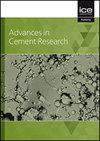仅利用废料获得的褐铁矿-CSA 水泥的合成与性能
IF 1.4
4区 工程技术
Q3 CONSTRUCTION & BUILDING TECHNOLOGY
引用次数: 0
摘要
白云石-硫铝酸钙(BCSA)熟料通常是通过燃烧由石灰石、粘土、天然石膏和铝土矿组成的生料,在低于 1350°C 的温度下获得的。研究人员调查了使用石灰石采石场废料、疏浚沉积物、水稳定污泥和烟气脱硫石膏完全替代天然原料的情况。在实验室电炉中分别合成了基于天然原料和废料的两种 BCSA 熟料。在相同的硫酸钙/叶蜡石比例下,将熟料与天然无水石膏混合,制备了两种 BCSA 水泥,并研究了它们的水化性能。用废料制备的 BCSA 水泥比用天然原料制备的水泥早期反应更快。在后期龄期,两种水泥都形成了相似的水合物组合,主要由埃特林岩、AFm 相和斯特林岩组成。此外,两种水泥的物理性质(即抗压强度、孔隙率和体积稳定性)也非常相似,但用废料制成的水泥的后期抗压强度(56 天后)明显更高。结果表明,完全利用当地废料生产 BCSA 熟料是可行的。本文章由计算机程序翻译,如有差异,请以英文原文为准。
Synthesis and properties of a belite-CSA cement obtained using only waste materials
Belite-calcium sulfoaluminate (BCSA) clinkers are usually obtained at temperatures lower than 1350°C by burning a raw meal composed of limestone, clay, natural gypsum and bauxite. The use of limestone quarry waste, dredged sediments, water potabilization sludge and flue gas desulfurization gypsum as complete substitutes for natural raw materials was investigated. Two BCSA clinkers based on natural raw materials and on waste materials, respectively, were synthesized in a laboratory electric furnace. Two BCSA cements were prepared by blending the clinkers with natural anhydrite at the same calcium sulfate / ye'elimite ratio, and their hydration behaviour was investigated. The BCSA cement made from the waste materials showed a faster early reaction than the one prepared from natural raw materials. At later ages, both cements developed a similar hydrate assemblage, consisting mainly of ettringite, AFm-phases and strätlingite. Also the physical properties, i.e. compressive strength, porosity and volume stability, are rather similar, with the exception that late compressive strength (after 56 days) is significantly higher for the cement made from waste materials. The results show that it is possible to manufacture BCSA clinkers entirely from local waste materials.
求助全文
通过发布文献求助,成功后即可免费获取论文全文。
去求助
来源期刊

Advances in Cement Research
工程技术-材料科学:综合
CiteScore
3.70
自引率
5.00%
发文量
56
审稿时长
3.2 months
期刊介绍:
Advances in Cement Research highlights the scientific ideas and innovations within the cutting-edge cement manufacture industry. It is a global journal with a scope encompassing cement manufacture and materials, properties and durability of cementitious materials and systems, hydration, interaction of cement with other materials, analysis and testing, special cements and applications.
 求助内容:
求助内容: 应助结果提醒方式:
应助结果提醒方式:


